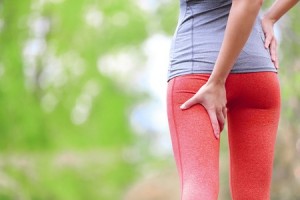Low Back Pain and the Hamstrings
To download a copy of this week’s newsletter, please click here.
Houston Chiropractor Comments: Have you ever considered how important your hamstrings muscles are in relationship to the low back? Most people do not think about those tight muscles on the back of the upper leg / thigh as having much to do with low back pain (LBP). However, it is one of the most important muscles groups to keep loose both as a means of improving current low back trouble as well as preventing future LBP. Think of the hamstrings as a stabilizing guide wire that keeps us upright. When we bend over with our knees straight, we can feel the hamstrings gradually tighten, often limiting us from reaching our toes. When the hamstrings are too tight, some of us can hardly reach past our kneecaps as we bend over. We then (unconsciously) bend our knees to put slack in the hamstrings so we can easily reach the floor.
The low back is only so flexible and in reality, most of our ability to touch our toes comes from our hip joints. In fact, after scoliosis surgery where metal rods are placed on both sides of the spine, these patients will often make up for the loss of low back movement by increasing hip motion and still be able to touch their toes! This, however, can only be accomplished if the hamstrings are stretched to a point of allowing the hips and pelvis to rotate forwards when bending with the knees straight.
So, what happens if the hamstrings are too tight? Think of a young sapling tree branch versus an old oak branch. When bending the two branches, the young sapling can easily bend, while the old oak branch breaks early into the process. Similarly, as we bend over to lift a box, when the back and leg muscles, ligaments, and tendons are tight, something has to give or “break,” similar to the old oak branch. The “weak link” in the injured person bending over may be a disc that ruptures, ligaments and/or muscle tendons that overstretch and tear. By keeping the hamstrings loose (like the young sapling branch), much less force is placed on the spine because the pelvis can rock forwards during the bending process, thus unloading the spine. Another way to look at it is that when the hamstrings are too tight, something else has to be correspondingly loose to make up for the tight hamstrings or else the task of bending forwards and performing daily tasks will be limited.
Tissues in our back are injured when forces exceed their capacity to withstand the load. By keeping our hamstrings stretched, we reduce the need for our spine to have to make up for the tightness; thus both preventing a new injury, as well as perpetuating a current problem. The best way stretch the hamstring’s is to sit down on the ground with one leg out straight and the other heel pulled towards your groin. Try and touch your toes with the toes pointed out, up and then in. Maintain that position for at least 10 and then switch legs and do it 3 times each side. Because the hamstrings tighten up during sleep, it’s usually best to perform the stretch in the morning. Repeating this multiple times a day may be required to obtain proper hamstring muscle length. Exercise training is a routine part of chiropractic care!
If you, your family, or a friend is struggling with low back pain, sharing this information may be one of the greatest acts of kindness you can give to that person. At this clinic, we strive to provide the highest quality care and follow evidence and “best practice” approaches. We greatly appreciate the trust that our patients place in us and our services as we help them recover as well as teach ways to prevent future LBP episodes.
Dr. Ward Beecher practices at his Houston Chiropractic Clinic at 1001 Pineloch, Ste 700 Houston, TX 77062. You can schedule an appointment at BeecherChiropractic.com or by calling (281) 286-1300. If you have any questions regarding this blog, please comment below!

